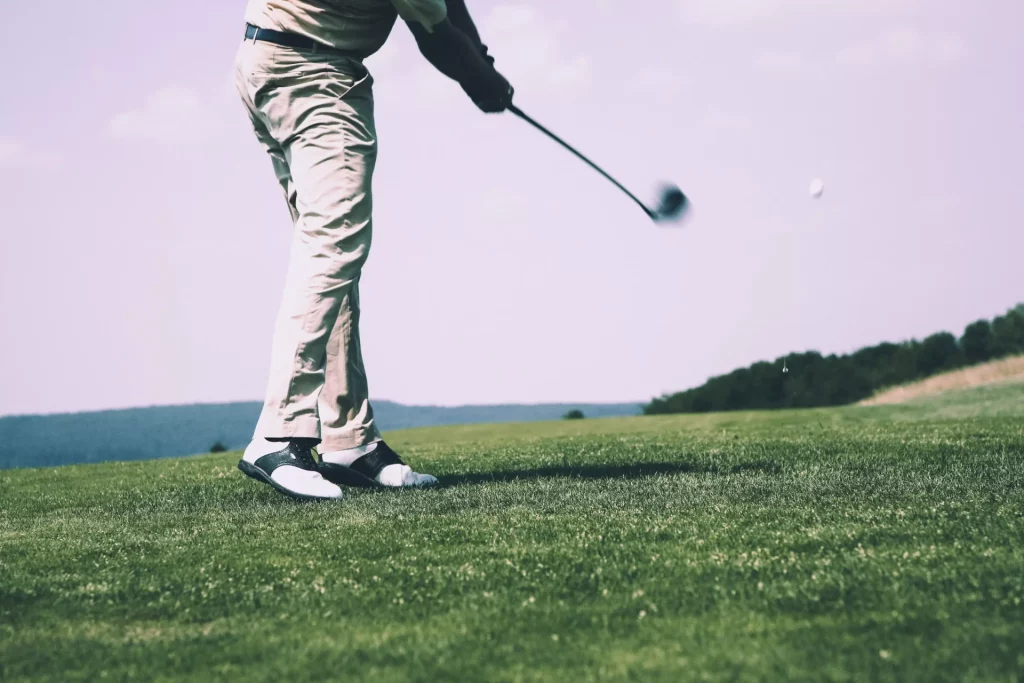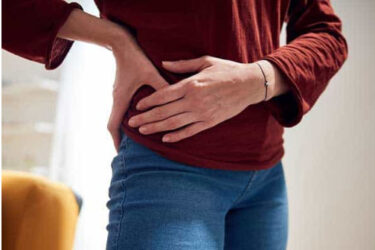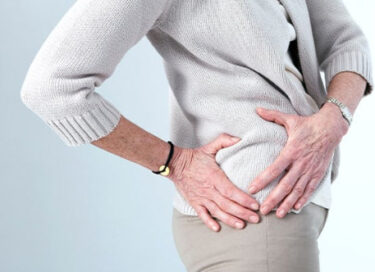Whether you prowl the greens like Tiger or create your own bunkers on the fairways, golf is a sport that’s almost inexplicably addictive. As Microsoft owner and tech businessman Bill Gates once said of the game:
“I find golf very relaxing. It’s a way to get away from work and get outside. It’s a lot of fun and once you get going, it’s kind of addictive.”
Bill Gates, co-founder of Microsoft
But what happens to that enjoyment if you need hip surgery? Will you still be able to get out in that fresh air and swing a club? Join us as we explore the relationship between golf and your hip health while answering the question: can you play golf after a hip replacement?

Is golf bad for your hips?
While rugby has heavy hits, football has sliding tackles and skiing has the potential for falling off a mountain, golf is just a leisurely walk in the countryside. Right? Well, yes and no.
Golfers aren’t as immune from injury as you might think, especially when it comes to hips and knees. The repetitive nature of the golf swing means that golfers are performing the same action of hip rotation over and over again. In fact, when you think about it, the average player is probably performing the same motion over a hundred times during a golf game. This puts pressure on the lead hip (the one attached to your front leg at the end of your swing) and the surrounding muscles. Over-rotating and not keeping your upper body still during your swing can exacerbate any issues that may arise.
Common golf-related hip injuries
Muscle strain, tendonitis and osteoarthritis are all relatively common hip problems that can either be caused by golf, or worse by continuing to play.
Among the more serious golf-related hip injuries are:
- Stress fracture
- Labral tear or hip impingement
- Loose bone or cartilage in the joint
Treating hip and groin pain from golf
If you’re experiencing persistent hip pain while playing, the first thing you should do is rest. Putting the clubs away for a few weeks could benefit you in the long run and give your injury a chance to heal.
Heat and ice treatment could also be effective at managing the injury, along with limiting the amount of weight you’re putting through the affected joint. Your doctor should be able to give you some helpful tips and advice when it comes to treating your hip pain.
Golf hip pain exercises
Once you’ve given yourself enough time to rest and recover, you should start some exercises. These will rebuild the strength in and around your affected hip. You’ll want to target your glutes, lower back and the thighs to give your body the best chance of absorbing and managing the strains of playing golf. Your doctor should be able to provide a list of specific exercises to try.
Hip stretches for golf
Regardless of what physical activity you’re doing, you should warm up beforehand. Stretching both before and after will warm up and prepare the muscles for the activity, while relaxing them once your game is finished. Thorough stretching can also reduce the risk of injury, alleviate any symptoms of DOMS, and speed up your recovery in the hours and days following your activity.
Ask your doctor for specific stretching exercises to target your affected hip.
Hip mobility exercises for golf
One of the unfortunate consequences of our increasingly sedentary lifestyles is the loss of hip mobility. This can have a negative impact on your game beyond technique and timing. Limited hip mobility can lead to compensation on other parts of the body which can, in turn, increase the risk of injury. The following exercises can help:
- Step-ups: Standing up straight, raise one knee up in front of you to hip level. Keeping the knee at hip level, move your leg out to the side and make a full circle with your knee. Alternate between the legs five times.
- 90/90s: Sitting on the floor, place one leg in front of you, bent at a 90-degree angle at the knee so your toes are pointed forwards. Put your other leg out to the side with your knee also bent at a 90-degree angle so the flat of your foot is facing directly behind you. Using your hips, lift your bottom off the floor and sit up tall over your front leg. You can use your hand to support if needed. Repeat this exercise 10 times before switching so your front leg is now out to the side.
Physiotherapy
A physiotherapist can offer you advice, stretches and exercises tailored to your specific needs. If you’re experiencing hip pain or wish to know more about stretching and exercises to strengthen your hip, it’s a good idea to consult a physiotherapist.
Partial or total hip replacement
If you’re experiencing pain in your hip joint that’s affecting your golf game, you should consult your doctor. He or she should be able to recommend a specific course of action that’s tailored to your needs. Long-term hip pain may result in a prolonged period of rest, a strengthening and recovery plan, or even hip joint replacement surgery.
Can I play golf after a hip replacement?
If you’re making plans to go under the knife or you’re on the road to recovery, you’re probably wondering whether you can play sport and exercise after total hip replacement surgery.
For the majority of patients, the news is good: after a period of recovery, you should be able to return to golfing action. In some cases, a consultant may advise against picking up your clubs again, while the speed of recovery from hip replacement varies from patient-to-patient.
How long after a hip replacement can I play golf?
Just as golfers differ from one another in their playing style and on-course fashion choices, no two will be the same when it comes to recovering from a hip replacement. Some may be able to start playing much sooner than others, while their playing partners face a much longer wait before they can return to golf. As a general rule, patients that have had hip replacement surgery should aim to return to golf after 12 weeks. Patients should seek the advice of their doctor before resuming or starting a new activity following surgery.
Does having a hip replacement affect your golf swing?
While the majority of hip replacement patients will be able to return to prowl the fairways, they may have to make some adjustments to their swing. For example, some doctors and golf pros may recommend lifting the front heel off the ground during the backswing. This is to reduce the amount of stress placed on the affected joint and the surrounding area.
What is the best golf swing after a hip replacement?
The answer to this question will differ from golfer-to-golfer. If you’re returning to the course following hip surgery, you should consider taking a few lessons with a pro. They should be able to make the necessary adjustments to your swing and provide hints and tips as to how you can reduce the amount of stress on the affected joint.
Has any professional golfer had a hip replacement?
While it isn’t an endless list, there have been a number of famous athletes that have had knee or hip replacement surgery and made successful returns to their sport. Golfers are no exception. From Jack ‘The Golden Bear’ Nicklaus to Tom Watson, there are a handful of big names that have gone from the operating theatre to the drama of the golfing Majors.
Pro golfers with hip replacements
There are some big names in the list of golfers who have received a hip replacement. Among the senior players are:
- Jack Nicklaus, winner of a record 18 Majors and considered one of the greatest golfers of all time
- Tom Watson, eight-time Major winner
- Davis Love III, one-time Major winner and two-time US Ryder Cup captain
While there aren’t many big name players currently on tour that have received a hip replacement and returned to the heady heights of the leaderboards, Brooks Koepka is one most golf fans will recognise. From 2020 through to 2022, his golf was plagued by injuries, all stemming from recurring hip and knee problems.
Tips for getting back into golf after a total hip replacement
So, the surgery is done, the anaesthetic is wearing off and you’re dreaming about that bright sunny day when you make your return to the 1st tee. Dreaming is for free, of course, but it’s important not to get too carried away with thoughts of putting your golf shoes back on within the week.
In fact, speaking of golf shoes, when you’re ready to make your return it’s a good idea to invest in a pair of good shoes. A specialised golf retailer or pro should be able to help you choose the best golf shoes after hip replacement.
Among some other tips for getting back into the swing of things:
- Choose a good weather day: golf is a fair weather sport anyway – no-one likes playing in the rain – so teeing off when the sun’s shining can make all the difference to your mental wellbeing while reducing your risk of slipping and falling over.
- Use the right equipment: As a general rule, when standing on its end, your longest club (usually your driver) should come just past your hip. Using clubs that are too short or long for you will put pressure on the key joints and muscles used in the golf swing which, in turn, could lead to injury. Ask a golf pro for more help and information.
- Use a caddy: if you don’t like the idea of carrying your own bag, you can ask a friend to do it for you. Alternatively, hiring a buggy is another option that will be worth the money given the stress you’ll be taking off your affected joint.
- Practise your technique: once you’re back playing, it’s likely you’ll need to make some adjustments to your game. It’s time to grab a bucket of balls and hit the driving range! On the range you can take your time while figuring out what works for you and what doesn’t. Following your hip replacement, you may need to use bigger hip turns or shorten your backswing. A lesson or two with a pro should be able to help you find a comfortable swing action and practise your technique.
- Remember to warm up: and don’t forget to cool down either! Stretching before and after your round will help loosen your muscles while taking the stress off your affected joints.
Remember, take it slowly. Everyone heals at different rates and your recovery won’t be an overnight miracle. Follow your exercise plan and seek advice when needed.
Golf exercises after a hip replacement
While there are more exercises aimed at golfers than you can shake a 9-iron at, not all will be effective for you. Consulting a physio or golfing pro is a good idea, particularly when you’re making your return to the game. He or she will be able to provide you with hints and tips that are tailored to your specific needs.
Learn more about hip replacements and golf
At Practice Plus Group, we’re passionate about providing you with a positive experience during your hip surgery and treatment, while delivering personalised care every step of the way. Whether you’re paying for yourself or using private medical insurance, with our short waiting times, unrivalled Care Quality Commission (CQC) ratings and high levels of cleanliness, we’ll make sure you’re looked after.
Take a look at our Private and NHS care options for information and advice on booking appointments to choosing the right hospital for your treatment.





